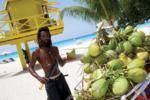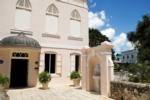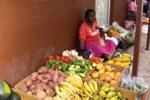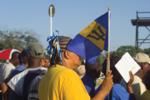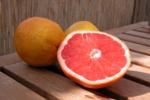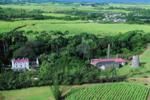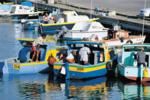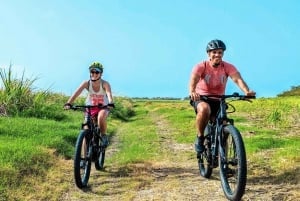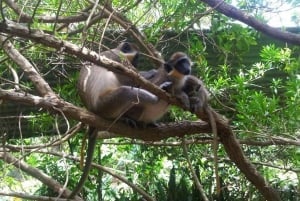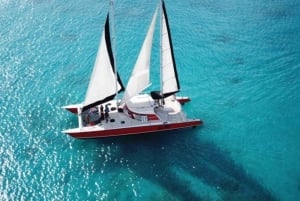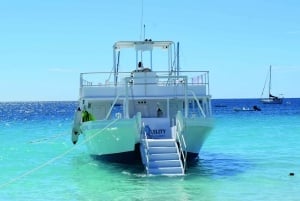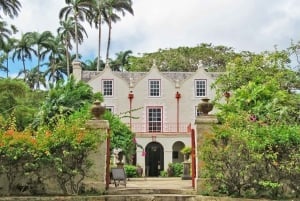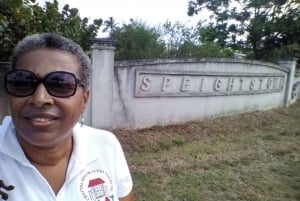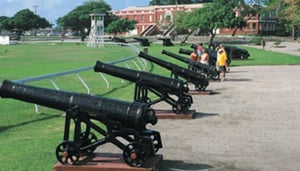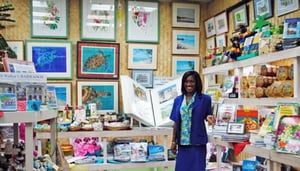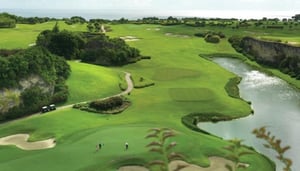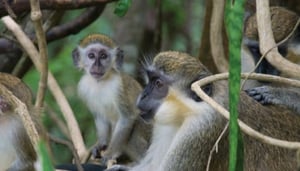A to Z of Barbados
There is an extraordinary number of things peculiar to this 166-square mile island settled over 380 years ago - chattel houses, black belly sheep, road tennis, mauby, salt breads, flying fish and cou cou, zouaves and tuk bands are all uniquely Bajan.
Architectural Heritage - The historic architecture of Barbados includes domestic, military, industrial or sugar plantation and religious buildings. In the 1650’s stone building had begun with St. Nicholas, and Drax Hall still surviving intact. By the mid-ninteenth century, Barbadians were evolving their own vernacular or domestic architecture. As in other parts of the British West Indies, Georgian tradition was modified in terms of materials, climatic needs and individual, local styles to produce a range of uniquely Barbadian vernacular creations, from the highly original chattel house to the very fine but quintessentially Barbadian plantation great houses like Villa Nova. Another uniquely Barbadian creation was the suburban villa with its scalloped front parapet wall and simplified Palladian portico. Barbados lacks a comprehensive preservation policy but fortunately there have been some renovations and adaptations of the islands’ many architectural gems. The Barbados National Trust was founded in 1961 "to promote the preservation of places of historic and architectural interest and of natural beauty or ecological importance." The Trust has published a number of books on the heritage of Barbados. Barbados National Trust plaques have been affixed to some historic buildings in Barbados. Their Open House program held on Wednesday afternoons from January to April is an enjoyable way to see some outstanding homes and an important fund raiser. The Barbados National Trust welcomes new members and is in dire need of funds and man power.barbadosnationaltrust.org/
Bajan - pronounced 'Bay-juhn', is a term you are sure to hear often during your stay in Barbados. It is a colloquial, shortened way of saying 'Barbadian' which refers to anything made in or originating from Barbados, including the quasi-English dialect spoken by locals. Citizens of the island are also known as Bajans.
Banks - the beer of Barbados and one of the best beers in the world. We're not biased, really! A smooth, refreshing lager with a light, crisp taste. Banks is best served ice cold, even better while enjoying a game of cricket or a Paynes Bay sunset. Exactly.
Bentley - A bentley is a non-alcoholic beverage, equivalent to rum punch. It is reputedly named after David Williams Bentley, Bishop of Barbados from 1927 to 1945, who is said to have invented it to encourage moderation among his flock. Fresh lime juice and sugar are also used to make lemonade (still) and lime squash (fizzy).
Black belly sheep - The black belly sheep seems to have originated and evolved in Barbados from two ancestral stocks, one being an African hair sheep (suited to this warm climate) and the other a European wool sheep (with a high reproductive rate). The meat is tasty and tender. The keeping of "stocks" helped many households in the last two centuries make ends meet, and it was often the childrens’ first and last job every day to take them out to pasture and fetch them back in. This practice still exists in village life today but it is usually the older folk who tend to the animals. Black belly sheep are reared commercially in Barbados and in several other tropical countries.
Breadfruit - Most of you will have heard the story of Captain Bligh and Mutiny on the Bounty, but do you know what caused that particular mutiny? The Bounty was sent to Tahiti in 1789 to take saplings of the breadfruit tree and transport them to the West Indies for cultivation. The expedition failed when the crew mutinied during the second leg of the journey. They didn’t like the idea that they were dying of thirst whilst the plants were still being watered. Several years later the breadfruit plants finally reached St. Vincent, and from there saplings eventually reached Barbados. Breadfruit is delicious and nutritious, and can be prepared in the same manner as any starchy vegetable.
Casuarina trees - You may have noticed a profusion of these around the island. During World War II when timber was in great demand, you had to pay extra tax on open land without trees.
Chattel houses - This distinctly Barbadian design has its roots in the emancipation of slavery. Through the Located Labourers Act of 1840 former slaves were allowed to build their humble homes on marginally productive plantation lands at peppercorn rents, but the plantation reserved the right to evict tenants from these tenantries at short notice. Houses therefore had to be ‘chattel’, which means ‘moveable possession’ and for this reason were built of timber. They could be easily dismantled in sections, moved to another spot on an ox-cart (today a truck), and re-assembled in a single day, and yet be able to survive this process with minimal damage. The householder built the house to suit his financial resources and his needs. First a single unit with two rooms, later a shed was added behind. Later still, another roof was added and another, and then maybe an addition of "wall" in the back. The traditional window was a wooden louvred window with hoods that gave privacy and kept out the glare of the sun while letting in a cooling draft. Most houses had a paling - a fence of corrugated iron sheets to provide complete privacy in the backyard of the house. This was usually made with recylced roofing material. The gingerbread trim, various carved wooden features and elegant porches could continue to be added as finances allowed, making the chattel house always a work in progress. The traditional colours of these houses were brown, ox blood and cream. The Heritage Village at Tyrol Cot features six chattel houses, which are replicas of some of the finest surviving examples across the island.
Coast Guard - The Barbados Coast Guard is one of the best equipped and most efficient in the Caribbean and is responsible for defence, fishing protection and search and rescue.
Coat of Arms - Presented by Her Majesty Queen Elizabeth II in 1966 (the year of Barbados' Independence). There is a golden shield portraying a bearded fig tree beneath two blooms of the Pride of Barbados; the crest includes a helmet, gold mantle and the arm of a Barbadian holding aloft two crossed pieces of sugar cane. Standing to the sides are a dolphin to represent the fishing industry and a pelican reminding us of the earlier days. Beneath is the nation's motto: "Pride and Industry".
Coral - Beneath the terra firma of Barbados is a coral limestone cap that filters the underground water reserves of the island. Over thousands of years, water moving through the limestone cut out a series of caves, the best known of these being Harrison's Cave which was rediscovered in 1970 by Ole Sorenson. It has since then been developed by the government of Barbados, with painstaking care to preservation, as an attraction. Tunnels have been excavated to allow for tram tours through the caves with a major redevelopment and expansion project just completed.
Corn n Oil - This is a delicious cocktail made with equal measures of rum and falernum (a rum based syrup which is made only in Barbados) finished with a squeeze of lime and served with plenty of ice.
Desert Dust - On various occasions the sky over Barbados is veiled with a very fine, red dust, so providing hazy views but fantastic sunsets. This is dust from the Sahara Desert in Africa which is picked up by the wind and transported here by upper-level air currents.
Dolphin - This is not the porpoise-like mammal loved and admired by people, but the most popular large pelagic fish caught by local fisheries. A delicious moist "steak" fish, usually served fried or steamed with a tomato and onion butter sauce.
Dominoes - Usually referred to as 'playing cards', there isn't a minute in any day of the year that dominoes are not being played somewhere on the island. Indeed a good game can be heard from about half a mile away because the metal studded domino is placed on the playing surface with an almighty slam, originating from as much as 3 ft. above. It is thought that the ancient game of dominoes was made popular in Barbados by Barbadians who went to work in Cuba in the early part of the 20th century. The classic game is under a street light, on a piece of board or an old drum with four avid players, a sizeable audience and 'bere' noise! A potential 'six love' for instance attracts a great deal of attention. Anybody found in 'love' at the end of the game, that is with no points chalked on the board, can find himself the butt of a lot of good-natured teasing, especially if he was one of the loudest competitors at the beginning. A big part of the Bajan version of dominoes is trying to convince everyone else on the board that you already have the game in the bag, and the ability to read the game (or predict what others will play) is held in high esteem. It is a show of a player's prowess.
Fish Markets - All of the towns have fish markets with particularly quaint ones around the Eastern coast such as Tent Bay, Skeete's Bay, Martin's Bay and Consett's Bay and on the West coast in Speightstown and Payne's Bay. Oistins and Bridgetown have modern centres open all day.
Fish Seasons - October to June: flying fish, dolphin (no relation to the porpoise), barracuda, king fish, bill fish and albacore.
June to September: red snapper and pot fish such as parrot fish and chubs.
Flying Fish - Barbados is renowned for this fish which has been clocked soaring through the air at speeds of 55km per hour for as long as 13 seconds at a stretch. It does not fly but in fact leaps through the air propelled by its tail fin, pectoral and ventral fins. It is found around Barbados from December to June. De-boning a flying fish is a skill involving the swift removal of hundreds of bones that is not generally practiced in other islands. There are flying fish de-boning competitions held at the Oistins Fish Festival with the fastest de-boner crowned as champion.
Fruit (seasonal) - Fruit is not grown on any large scale but many people have orchards in their back yards. Fruit grown in Barbados include lime, shaddock, grapefruit, seville orange, golden apple, mango, avocado pear, Barbados cherry, and passion fruit. In fact, the grapefruit is thought to have originated in Barbados as a natural cross between a shaddock and a sweet orange. The weird and wonderful seasonal fruit, most of which grows wild and is sold by roadside vendors, include ackees, chili plums, hog plums, dunks and occasionally Barbados cherries, fat porks and sea grapes.
Government House - A splendid piece of old architecture situated in Pine Hill, St. Michael. You may pass a very attractive gate and gatehouse where you will see the sentry standing smartly to attention.
Hurricanes - The hurricane season is from June to October but, thankfully, Barbados is very seldom affected by such bad weather. The last time the island suffered from a direct hit was in 1955 and before that 1898. Modern meteorological and communication systems ensure that there is plenty of warning of any impending danger.
Lime - more than a great source of Vitamin C, in Barbados a 'lime' is a great way to spend an evening - casual, with friends, food, and lots of laughter.
Mauby - Mauby is a refreshing cold beverage made from the bark of a small, shrubby tree. It has an unusual bitter flavour. The drink is made by boiling the bark with some spice and essence and sweetening to taste. There are several brands of concentrate prepared and sold locally.
Page 1 2


